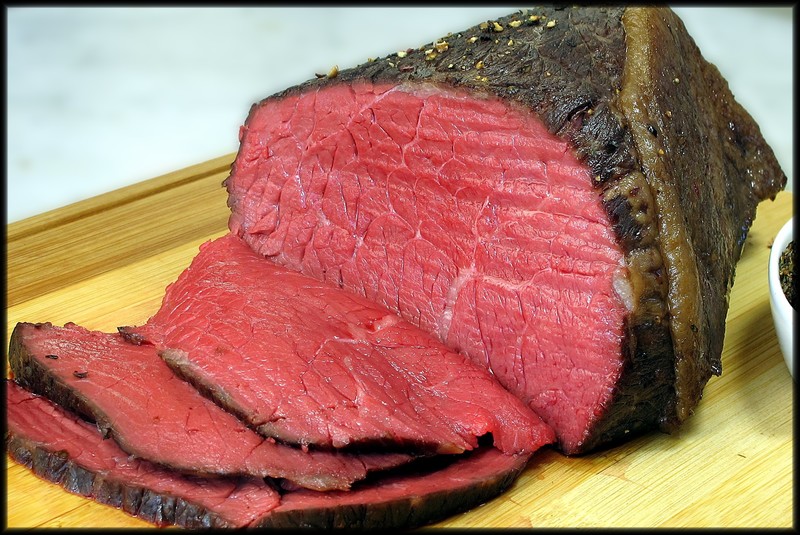Today is Valentine’s Day, and despite all the tempting advertisements for dinner specials, it’s one of the worst days of the year to dine at a restaurant. Comparable to the challenge of taking your mom to brunch on Mother’s Day, everyone has the same plan. Instead, consider using the holiday as an opportunity to serve your sweetheart’s favorite dish.
|
TEMPERATURES |
||||
In our house there’s more than one favorite, but they all have the same main ingredient: beef. And when planning the full menu, potatoes are a required component. As I started planning our Valentine’s Day dinner, I rejected hamburgers as too mundane. Steak wasn’t an option; who wants to fire up the grill with a snowstorm in the forecast? Roast beef it would be.
Although I grew up with the family tradition of a roast served every Sunday for dinner, I never paid attention to the roasting process. With only two of us at the table now, roasting a large piece of meat isn’t something I regularly practice, so some research was in order before we turned on the oven.
Just for clarification, there are two different kinds of roast beef: oven roast and pot roast. Pot roast is braised in a liquid in a covered pan for a long time at a moderately low temperature, typically until the meat is fork tender. Oven roasts are dry roasted in an open pan until the beef reaches the desired degree of doneness, typically medium or medium rare for the best texture and flavor.
While pot roasts can be successfully prepared from tougher cuts of meat like brisket and chuck, you’ll want to go for a more tender cut of beef for dry roasting. In order of both decreasing price and tenderness, choices include: prime rib (which is sold on the bone), tenderloin, sirloin and round. The two types of round roast are top round, which has a more uniform shape, and bottom round or rump roast. These last need to be sliced very thin or they can be chewy.
Oven roasting proponents have two different points of view about the correct method of temperature and timing: high and fast or low and slow. According to America’s Test Kitchen, low and slow is the correct choice. If you can prevent the internal temperature of the beef from exceeding 122 F for as long as possible, natural enzymes (which are destroyed above that temperature) help tenderize the meat.
One obstacle to this temperature-controlled approach is that most ovens can’t be set for less than 200 F. A simple solution is to start by searing the meat in hot oil in a skillet and then placing it in an oven preheated to 225 F. After about 90 minutes, check the meat thermometer you previously placed in the piece of beef; turn off the oven when it reads 120 F.
While those enzymes are still working, leave the roast in the oven until its internal temperature is 5 degrees lower than your desired degree of doneness (see sidebar). Remove it from the oven to rest for about 15 minutes before carving. During this time, you’ll see the temperature continue to rise to reach the ideal level while you share a preprandial cocktail with your sweetheart.
In addition to the instructions for slow and low roast beef, I’ve also included recipes for shallot-infused mashed potatoes and a creamy horseradish sauce for the meat. Now you’re ready for Valentine’s Day dinner - thinly slice your perfect roast and serve it to your sweetie. Don’t forget the chocolate for dessert!
Slow and Low Roast Beef
3-4 lb eye round
kosher salt
pepper
2 T olive oil
The night before, sprinkle kosher salt on the meat to coat all sides and seal in plastic wrap. Refrigerate for up to 24 hours. Remove meat from refrigerator about 1 hour before cooking. Preheat oven to 225 F. Pat meat dry and sprinkle all sides with salt and pepper.
Heat olive oil in a skillet over medium high. Brown the meat on all sides and place on a rack in a roasting pan. Deglaze the browning skillet with beef broth, scraping up any bits; reserve for gravy. Insert a meat thermometer in the thickest part of the roast and place roasting pan in the oven. After about 1 1/2 hours, check the thermometer without opening the oven door. Once the temperature reaches 120, turn off the heat and leave the pan in the oven. Check the thermometer every 15 or 20 minutes until it reaches 5 degrees below your desired degree of doneness. Transfer roast to a carving board, tent with aluminum foil and allow to rest for 15 minutes before slicing. Yield: 6 to 8 servings.
Horseradish Sauce
1 C sour cream
1/4 C prepared horseradish
1 T lemon juice
1/8 t lemon zest
salt & pepper, to taste
Mix ingredients in a small bowl until thoroughly combined. Adjust seasonings to taste.
Shallot Mashed Potatoes
2 lbs small red potatoes
1 t salt
3 minced shallots
3 T butter, divided
1/4 to 1/3 C half and half
salt & pepper, to taste
Clean the potatoes and halve any that are too large, so all pieces are about the same size. Place potatoes in a saucepan with enough water to cover. Add salt and bring to a boil over high. Reduce heat to medium low and simmer until tender, about 20 minutes. Meanwhile, melt 1 T butter in a small skillet over low heat. Add minced shallots and sauté until softened; set aside. Drain potatoes and return them to the same pot. Place the pot over very low heat and cook to evaporate any remaining water. Remove from heat and add remaining 2 T butter. Mash with a potato masher, adding half and half to reach desired consistency. Stir in cooked shallots and adjust seasonings to taste. Yield: 4 servings.























































